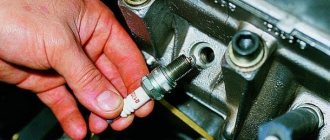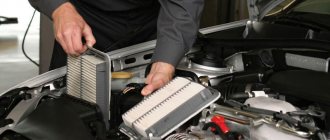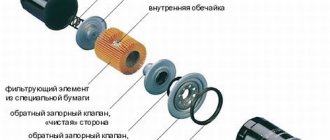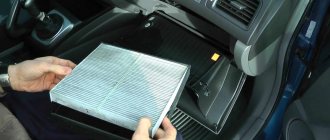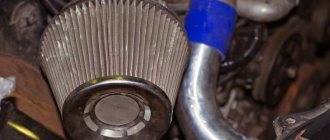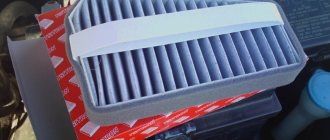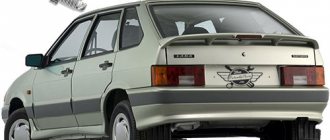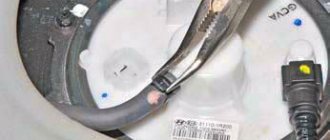The state of the modern environment cannot be called ideal. There is polluted air all around, full of dust, foreign solid microparticles, harmful substances and other natural “surprises”. And in such conditions, drivers must drive their cars.
What happens if solid microscopic elements contained in the air get inside the motor? Of course, it may fail very soon. The situation can be saved by installing an air filter that protects the engine from various microscopic objects in the air getting into it. But this part is a consumable, that is, it must be changed periodically.
Manufacturers often indicate the frequency of changing the air filter in the car user manual. But such information is only suitable for motorists living in ideal climatic conditions. Most of us live in conditions with moderate or even increased environmental pollution. Therefore, the filter must be changed 2 (in most cases), or even 3 times more often (for conditions with increased environmental pollution). Replacing the filter is a simple task that can be performed by any motorist. And the cost of a new filter is less than restoring a damaged motor.
What is an air filter
The main task of this consumable is to protect the motor from foreign microscopic bodies contained in the air. The appearance of the filter is made in the form of an accordion, made of a special material, the main property of which is the ability to prevent the movement of various solid microparticles. Every day the number of such foreign objects increases, which is the result of poor air flow inside the power unit. There are seals placed around the accordion, the purpose of which is to block the passage of air into the engine, bypassing the filter.
In general, ignoring the need to replace the filter or untimely installation is fraught with an increase in the rate of wear of engine parts and serious damage to the engine in the near future.
When replacing filters, the design of the vehicle must be taken into account. After all, not every car will fit, say, a filter of a different shape. In addition, the filters differ from each other in the way they purify the air (cyclone, inertia-oil, direct-flow filters). To use the purifier in climatic conditions with a moderate degree of pollution, you can use a regular filter; in climatic conditions with a high degree of pollution, you can use a heavy purifier.
When installing a filter, most car enthusiasts prefer analogues with zero resistance. Such parts are used during sports competitions, when cars need to move along tracks with a high degree of dust.
But, despite the good performance of filters with zero resistance during racing, the use of such devices on ordinary cars will not give the desired effect. They are expensive, and when installing them, it is necessary to carry out additional expensive tuning work, otherwise the efficiency of the zero-resistance filter will simply be zero.
How often should you change the fuel filter?
The fuel filter performs one of the most important functions in the operation of a car engine, namely, cleaning the fuel from debris, excess particles, debris, and dust so that they do not get into the cylinders and interfere with their operation. In modern internal combustion engines, fuel purification occurs in two stages: through a coarse filter and a fine filter.
The first is a nylon net stretched directly in front of the gas pump; it sifts out large debris - debris, shavings, sawdust from friction of parts, etc. The fine filter is somewhat more complex and comes in two types: remote and built-in.
The remote is located outside the fuel tank, usually under the hood or underbody of the vehicle. Only remote filters are installed in diesel engines, because they additionally include water sensors and a drain plug, and sometimes heating.
Built-in filters are part of the fuel pump and are more relevant on modern cars. Manufacturers are abandoning remote filters due to their outdated design, and only some brands, such as Volkswagen and AVTOVAZ, continue to use them.
Manufacturers regulate different service life of different types of filters. It is recommended to change the remote ones not so often - approximately every 30,000-40,000 km. Built-in ones are even rarer - about 100,000 km! It's better not to change at all. This is because replacing them will entail dismantling the fuel pump, which in turn can lead to disassembling the fuel tank, and this is hard and highly paid work. So it is advised to finish the built-in filters to the end; fortunately, they are made with high quality and for a long time.
The remote filter must be changed with care. Due to its location, there is a risk of clogging the fuel injector nozzles through the supply hoses.
Changing fuel filters too often without following the manufacturers' instructions is completely pointless. But, if dangerous signals appear in the operation of the engine - consumption has increased, traction has disappeared, the engine is acting up - the first thing you need to do is check them.
We recommend
“Replacing the engine oil filter: choosing a model and avoiding mistakes” Read more
When to replace the filter
Any driver can ask the question: “How often should air filters be changed?” No one can give an exact answer to this question. After all, each manufacturer has different standards for replacing this part. In addition, it is necessary to take into account the degree of environmental pollution in a particular region.
If some motorists prefer to replace the filter within a certain pattern, then if you replace it after driving every 10 thousand kilometers, it will definitely be able to protect your car from premature wear of engine elements. It is also necessary to replace the part if the following symptoms appear in the operation of the machine:
- Increased fuel consumption in the car.
- Significant reduction in engine power.
- An increase in the amount of CO2 in the exhaust.
If you identify these signs, you need to pick up the instructions and find there a description of the sequence for replacing the air filter.
How does dust destroy an engine?
In order for the combustion process in the engine to continue, it needs a large amount of air to burn the fuel entering the combustion chamber. If you do not use an air filter along with air, dust will enter the engine, which is a fine abrasive that can wear away metal like sandpaper.
Dust initially enters the gas distribution mechanism, where accelerated wear of the valve system can begin. Solid particles get between the seat and the valve, which erase their surface with each stroke. With such a long-term effect, the valve system wears out and begins to leak the mixture. Engine compression drops, fuel burns worse, as a result - consumption increases, unstable engine operation, drop in traction, accelerated wear of exhaust valves, inevitable repair of the gas distribution mechanism.
After the gas distribution system, contaminated air continues to move through the intake channel, entering the combustion chamber itself. Dust sticks to the engine walls and other parts that are lubricated with oil.
Gradually, with each subsequent movement of the piston, with each engine revolution, more and more dust enters the engine crankcase, contaminating the engine oil that is in the engine.
Oil - like a circulatory system, carries dirt throughout the engine, since the oil filter is not able to catch and retain such small particles. Grains of sand get between the rubbing pairs and begin to wear away the polished surface. The friction coefficient increases.
All this threatens accelerated wear of the liners, crankshaft, rings, piston pins, oil pump and everything that requires lubrication to operate. At the same time, dirt collects in the channels and clogs them. The lubricant circulation deteriorates - the engine gradually dies. Major renovations are inevitable.
How to change air filters
When starting to replace the filter element, it is necessary to take into account the design features of the car. Each manufacturer mounts and positions the purifier differently.
In general, the algorithm for replacing a filter in cars of different brands and models differs little. First, the driver opens the hood, then finds the air filter, and then examines its fastening (in most cases, it is fastened with simple latches). After this, the cleaner is removed and its condition is assessed.
Please note that filters can be disposable or reusable. Disposable cleaners are replaced immediately. Reusable ones can be cleaned with a vacuum cleaner. True, this method of car care cannot be called effective (the dirt accumulated on the cleaner is not completely removed). But still, after these manipulations, the purifier can still perform its functions for some time. After this, the new (or cleaned) filter is fixed again.
How often to change a car's cabin filter
A modern car is a rather complex mechanism consisting of the interaction of many systems. Some parts can last quite a long time, and there are some that require replacement quite often. Cleaning elements are those that must be changed more often than others in order to maintain the correct operation of the entire car. A filter for cleaning the air in the cabin is of no small importance.
It turns out that some car owners do not think about changing the cabin filter and use it for years. Craftsmen and manufacturers advise carefully monitoring its contamination and changing it approximately every 20,000-25,000 km. After all, the cleanliness of the air in the cabin depends on this. In addition, modern cars are also equipped with carbon filter elements, which not only clean the air of dust, but also eliminate unpleasant odors.
It is also necessary to pay attention to the environment. If it is exposed to gas pollution (metropolis) or too dusty (steppes), then you may have to change the cabin filter more often. Tips on this issue can also be found in the operating instructions for your car. It’s better, of course, to pay attention to the rate of contamination of the part and then rely on the experience gained, since each case is unique and depends directly on the operating conditions of the car.
Do not underestimate the importance of the cabin filter. Its unsuitability can lead to bad consequences. Firstly, the entire air system may deteriorate. Secondly, freezing of the evaporator radiator occurs. Thirdly, all this may create an unpleasant odor in the cabin, which will not be so easy to get rid of. In cars equipped with climate control, the entire operation of the system depends on the filter. If it fails to clean the air, there is a risk of serious damage.
We recommend
“Fine oil filter: reducing wear of engine parts” Read more
What the experts say
According to experienced car enthusiasts, changing the engine air filter should be combined with the procedure for changing engine oil. This is done after 10-15 thousand km of travel. Thus, the entire engine will be serviced to ensure its long and reliable operation.
To quickly complete the procedure, you need to read the user manual to understand the structure of the motor and obtain information about the design of the filter used. New air filters are purchased only taking into account the make of the car. If there are new modern devices in the auto shop, it is necessary to consult with specialists regarding the suitability of the cleaner for a particular car.
Other features of replacing the air filter
When replacing the air filter, it is necessary to determine whether the engine is new. In cars with new engines that have not been used under high loads, the oil is changed more often than the cleaner. The filter is replaced every other time when filling the lubricant.
In cars with diesel turbocharged engines, the conditions for using the cleaner require its replacement at each oil change during maintenance.
When to change oil, fuel, air and cabin filters in a car?
A modern car uses several key types of filter elements to ensure optimal
functioning of a particular vehicle system.
Such filters include: fuel
,
cabin
,
air
and
oil
, some of which require systematic
replacement
at each subsequent
maintenance
.
{banner_adsensetext} 1
.
FUEL FILTER
One of the most important procedures in the maintenance of a modern car, according to many auto mechanics, is the timely replacement of not even
the oil
, but
the fuel filter
, especially if the car is equipped with a
turbocharging
and/or
direct fuel injection
(for example,
GDI
,
TSI
,
Common Rail
and other mechanisms).
A fuel filter
is a special filter element of a vehicle’s fuel system, which is designed to filter out small particles of debris, dirt, dust and various deposits from the fuel mixture (gasoline or diesel fuel) in order to prevent them from entering the fuel supply mechanism. The fuel filter avoids the creation of plugs in the fuel pipes, and most importantly, prevents the fuel injectors from becoming clogged.
Thus, the performance of the vehicle’s fuel system as a whole directly depends on the cleanliness of this part.
Replacing the fuel filter does not take much time, but this procedure must be carried out regularly in accordance with the manufacturer's regulations for a particular car model in order to protect the engine not only from dust, dirt, rust, but also from various harmful impurities contained in it. one type of fuel or another. replacement interval
in a modern passenger car is on average once every 30 thousand kilometers in a car with a
gasoline
engine and once every 60-90 thousand kilometers in a car with
a diesel
engine.
{banner_reczagyand}
2
.
OIL FILTER An oil filter
is a special filter element that is designed to clean engine oil from wear products, for example, mechanical chips and impurities, due to which the technical fluid retains its properties for a certain period of time, which is included in it by the manufacturer during the operation of the vehicle.
Thus, the oil filter
prevents
the conversion of engine oil into an abrasive mixture, which has a detrimental effect on the friction surfaces of lubricated parts (pistons, connecting rods, bearings, the surface of the cylinder walls and other components).
As a rule, replaced
when
is updated
. This procedure is performed simultaneously with an oil change, and only if there is damage to the oil filter, additional intervention by specialists is required.
It is also extremely necessary to change the oil filter in case of heavy contamination, which cannot be removed by washing and cleaning it with special means.
replacement interval
in a modern passenger car is on average every 10-15 thousand kilometers or every time the engine oil is updated in a car, both with a
gasoline
and
diesel
engine.
The more often you change your engine oil
and
oil filter
, the better for your power unit.
Do not spare money on this procedure, since it is better to engage in timely prevention (maintenance) of this key component of any car than its expensive treatment (repair). We recommend purchasing inexpensive and time-tested brands of oil filters - Mann
and
Mahle
.
3
.
AIR FILTER An air filter
is a special filter element designed to clean the atmospheric air entering the power unit, and externally it is an “accordion” made of dense filter material with seals along the edges that prevent air from entering the engine bypassing this filter.
Replacing
the air filter
guarantees
stable
operation of all
engine systems
, since
the optimal
the cleanliness
of the air entering the fuel combustion system .
replacement interval
in a modern passenger car is, on average, every 2nd maintenance or 30 thousand kilometers, regardless of engine type.
Auto experts recommend updating this filter element as often as possible, especially if the car is equipped with a turbocharger. The more often
you
change
the air filter, the
longer
your car's power plant will last before major repairs.
4
.
CABIN FILTER The cabin filter
is a filter element that prevents dust, pollen, organic residues, dirt and other inorganic compounds from entering the car interior, the entry of which can have a negative effect on the human body.
If you neglect to timely update the cabin filter
, then the ingress of microparticles or various dirt, over time, causes accelerated
fogging of the windows
in the car, which leads to
poor visibility
, and also often leads to
damage to
the moving parts
air conditioning
compressor .
Cabin filter
, as can be understood from its name, is responsible for the cleanliness of the air inside the car interior, and, consequently, for the comfortable stay of the driver and passengers. Timely replacement of the cabin filter provides dry and clean air, which is so necessary when driving around the city, where a lot of time is spent in traffic jams.
We also note that if the air entering the car interior contains
a persistent smell
of exhaust gases, then the cabin filter must be replaced immediately
,
since it is located in a car where a large amount of exhaust gases penetrates, it is dangerous to health, and therefore may affect on traffic safety.
Thus, the replacement interval for
the cabin filter in a modern passenger car is carried out at each MOT (maintenance), that is, once every 15 thousand kilometers or as
indirect
signs
of severe
clogging
appear (fogging of the glass or a burning smell in the cabin when driving) .
Replacing all of the above-described
filters
installed in almost any modern car model that are on the market today can be
done
quickly
and
efficiently with your own hands
, thanks to which you
will save
a decent amount of money.
As a rule, the procedure for replacing
all key
filters
in a car takes no more than 1 hour, the main thing in this matter is to have the appropriate tools on hand (for reference: gloves, screwdrivers - Phillips and flat-head, a clamp for the oil filter, an adjustable wrench for the drain plugs and an empty unnecessary bucket for draining old oil) and desire.
Video
:
“When and
how
often to change filters and spark plugs in a car ? “
In conclusion, we note that the replacement intervals for oil, fuel, air and cabin filters, as a rule, vary depending on the type of engine and operating conditions of the vehicle.
In addition, the scheduled periods for servicing and replacing a particular filter are often clearly stated in the technical documentation (manual) for the car. Do not delay replacing certain filters, as the consequences of such savings can cost you a lot. THANK YOU FOR YOUR ATTENTION
.
SUBSCRIBE TO OUR NEWS
.
SHARE WITH YOUR FRIENDS
.
